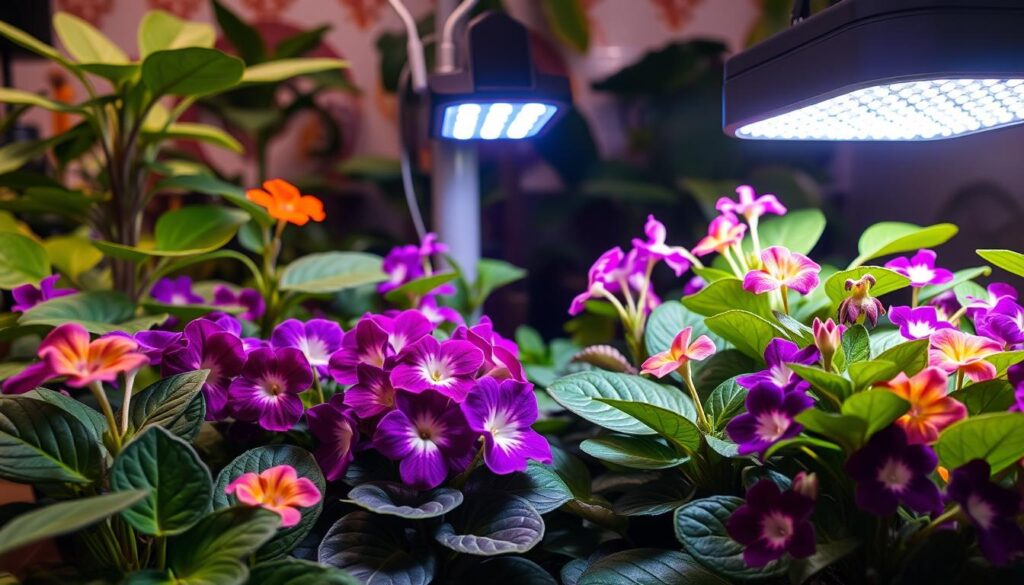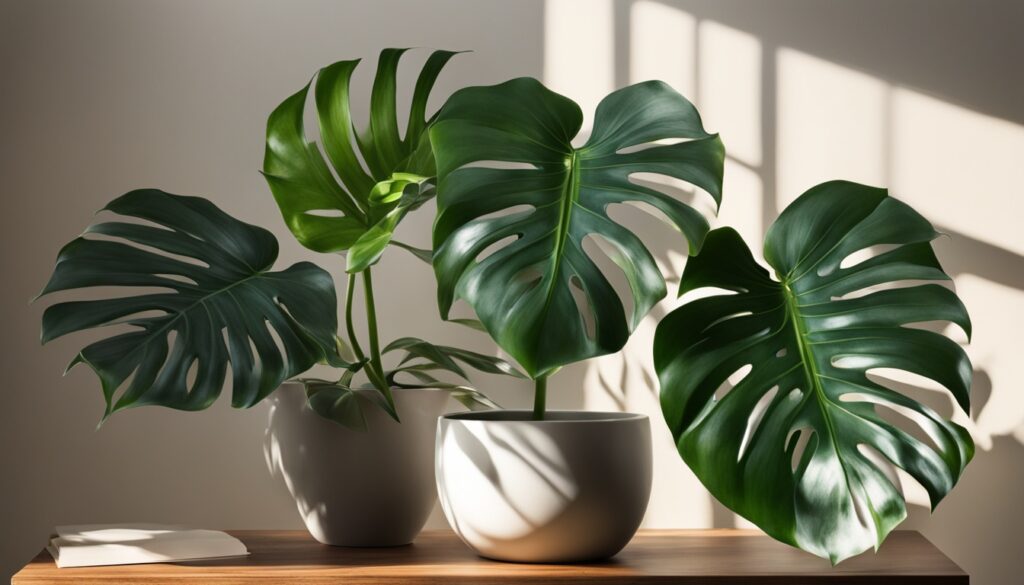Are you having trouble keeping your African violets healthy and blooming all year? The key might be the right grow light. These plants need specific light to grow well. The wrong light can make them grow too long, lose blooms, or even get sick.
In this guide, we’ll dive into what African violets need in terms of light. We’ll look at the best grow lights and show you how to set one up at home. You’ll learn how to make your African violets bloom brightly and stay healthy.
Key Takeaways
- African violets love bright, filtered light, just like their mountain homes.
- LED and fluorescent grow lights can give them the best light for growth and blooms.
- Adjustable, energy-saving LED lights are great because they let you control the light, don’t get too hot, and save money over time.
- It’s important to get the light distance, time, and type right for your violets to stay healthy and look good.
- Using a light meter to check the light intensity can help make sure your violets get just the right amount of light.
Understanding African Violet Light Requirements
African violets are delicate indoor plants that need specific light. They prefer shade in summer for lush foliage and plenty of sunlight in winter for blooms. It’s key to balance natural and artificial light for their growth and blooms.
Natural Light vs Artificial Light Needs
African violets can handle some direct sun but do best with bright, indirect light. In their native Tanzanian forests, they get dappled sunlight. To care for them indoors, artificial grow lights are needed all year.
Optimal Light Duration for Growth
- Some growers say 8-9 hours of light a day is best.
- Others think 10-12 hours of light is better for growth and blooms.
- Try adjusting light time in 30-minute steps to find what works for your plants.
Signs of Inadequate Lighting
- Reaching leaves mean the plant is stretching for more light.
- Tight, compact crowns show light stress.
- No blooms mean the light spectrum and duration are off.
Knowing the african violet lighting requirements helps you create the right light for these low light houseplants to flourish.
| Lighting Condition | Impact on African Violets |
|---|---|
| Insufficient Light | Leggy growth, lack of blooms |
| Excessive Light | Burned leaves, stress to the plant |
| Consistent Light Schedule | Healthy development and flowering |
“Both insufficient and excessive light stress African Violets, affecting their health and appearance.”
Types of Grow Lights Available for African Violets
Choosing the right light for your African violets is key. Violet grow lamps and LED grow lights are top picks. Each has its own benefits for these sensitive plants.
Fluorescent lights, like T5, T8, and T12 bulbs, have long been a favorite. They offer a full spectrum of light, great for both leaves and flowers. T12 bulbs are especially popular for their cost and effectiveness.
But, the market has changed, and LED grow lights are now a hit. They’re energy-saving and last a long time. LEDs use less power than fluorescents and don’t get hot, so they can be closer to the plants.
Many growers mix cool white and warm white LED bulbs for the best light. This mix helps with both leaf growth and flower production. LEDs can be adjusted to fit the needs of African violets.
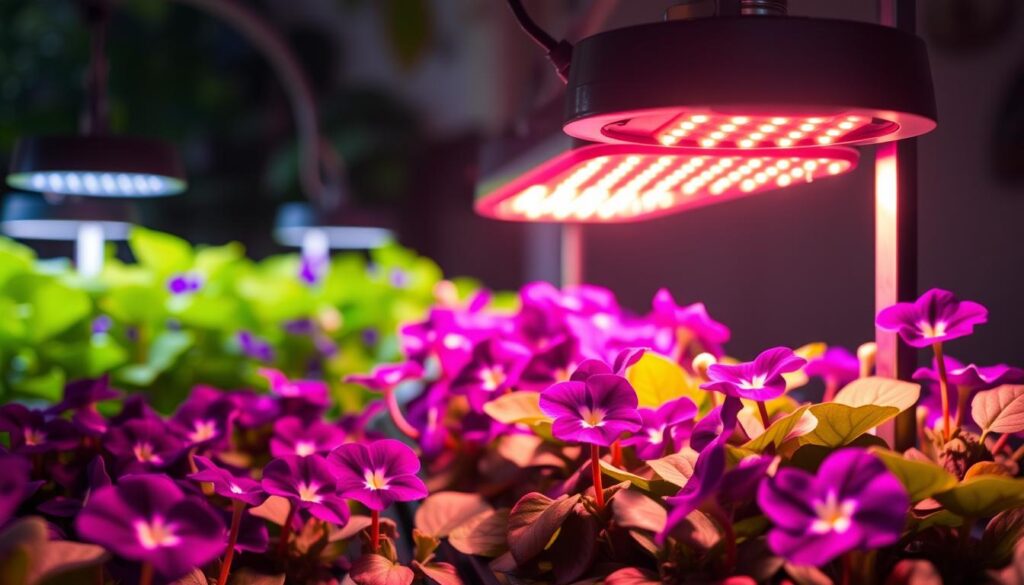
When picking grow lights for African violets, think about light intensity, spectrum, and coverage. This ensures your plants get the best light for growth and blooms.
LED Grow Light Benefits for Indoor Violets
LED grow lights are great for indoor African violets. They give the right light spectrum and intensity. This helps violets grow well, even in low light.
Energy Efficiency and Cost Savings
LED grow lights use much less electricity than other lights. This means you can save up to 50% on your energy bills. They are very energy-efficient.
Heat Output Considerations
led grow lights for violets don’t get hot like other lights. So, you can put them close to your plants. This ensures your violets get the light they need to grow well.
Lifespan and Maintenance
Good LED grow lights last a long time, up to 25,000 hours. You won’t need to replace them often. They are also easy to take care of, saving you time.
LED grow lights are perfect for growing African violets indoors. They provide the right light for your plants to thrive. This means your violets will have lots of leaves and flowers.
Fluorescent Light Options: T5, T8, and T12
Fluorescent lights are a top pick for growing violet plants and other houseplants. They come in different sizes, like the classic T12, the modern T8, and the super-efficient T5 bulbs.
The T5 bulbs are the most efficient, with a rate of 103 LPW. They outshine the T8 at 92 LPW and the T12 at 78 LPW. Also, the T5 bulbs have a co-efficiency of utilization of 0.90 CU, beating the T8 at 0.76 CU and the T12 at 0.46 CU. This shows the T5 bulbs are the best choice.
When it comes to color, T5 and T8 bulbs are equal, with a 85 CRI. But the T12 bulbs have a lower CRI of 62. So, the T5 and T8 bulbs offer a more natural and vibrant light for your violet plants.
For placement, T5 and T12 bulbs should be close to the plants, 6 to 12 inches away. T8 bulbs can be placed a bit further, 12 to 24 inches, without hurting growth. Remember, fluorescent bulbs need to be replaced every 6 months to keep the light strong.
Even though fluorescent lights are popular, LED lighting is becoming more popular. It’s more energy-efficient, flexible, and covers the light spectrum needed for violets. This could save money in the long run.

Grow Light for African Violets: Complete Setup Guide
Setting up grow lights for African violets is key. The distance between the light and plants is crucial for their growth.
Distance from Plants to Light Source
For fluorescent lights, place standard African violets 10-12 inches away. Miniatures and semi-miniatures need 6-8 inches. LED lights can be closer because they don’t get hot.
Coverage Area Calculations
The area covered by your grow light matters. It depends on the light’s intensity and type. Make sure all plants get even light by adjusting their position or using risers.
A good grow light setup is vital for your African violets. By choosing the right distance and coverage, you’ll create a perfect light environment for them to thrive.
“Proper lighting is the foundation for successful African violet cultivation. With the right grow light setup, you can unlock their full potential and enjoy vibrant, healthy plants.”
For a successful grow light setup, balance light intensity, coverage, and distance. Follow these tips to create a great environment for your African violets to grow and bloom.
Light Spectrum and Color Temperature
When it comes to indoor plant lighting, the light spectrum and color temperature are key. They help African violets grow and bloom. A mix of cool white (5500K-6500K) and warm white (3500K) violet grow lamps is best for these plants.
Some African violet types love high blue light (6400K). Variegated leaves do well under warmer 4000-5000K light. LED lights let growers adjust the spectrum. Some mix 6400K and 3000K for both leaf and flower growth.
| Light Spectrum | Recommended Color Temperature | Optimal Use |
|---|---|---|
| Cool White | 5500K-6500K | General African Violet Growth |
| Warm White | 3500K | Enhancing Bloom Development |
| Blue Light | 6400K | Promoting Vibrant Foliage |
| Warm-Cool Blend | 4000K-5000K | Ideal for Variegated Violets |
Knowing the lighting needs of African violets helps gardeners set up the best indoor plant lighting. This ensures their plants grow well and bloom fully.
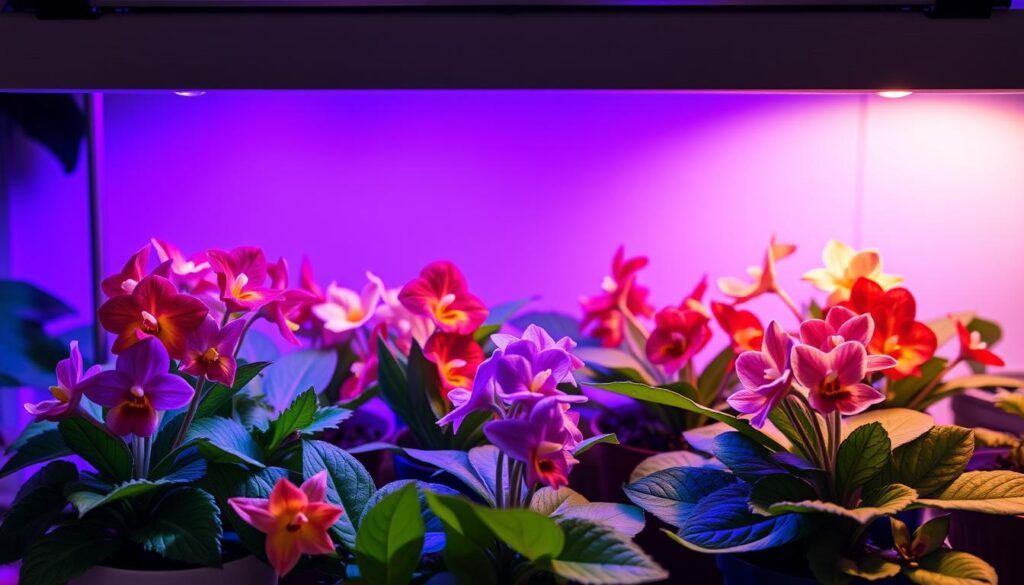
“Proper lighting is the key to successful African violet cultivation, as it directly impacts their growth, foliage, and flowering.”
– Dr. Minh Bui, African Violet Expert
Measuring Light Intensity for Optimal Growth
Getting the right light is key for your African violets to grow well and bloom brightly. Light meters help you check the light levels. This way, you can adjust the environment for the best growth.
Using Light Meters
Light meters measure light in foot-candles (fc) or lux. This tells you how much light your African violets get. For most varieties, 3,000-3,500 lux is best. Mini and semi-mini types might do better with 4,500-5,000 lux.
PPFD and Lumen Requirements
With new tech, more people use PPFD (Photosynthetic Photon Flux Density) for LED grow lights. African violets need 50 to 200 μmol/m²/s. This depends on the plant and how close it is to the light.
By watching and tweaking the light, your African violets will get the right amount. This leads to strong growth and lots of flowers.
“Rototing the plant every time you water, turning the planter a quarter of the way around, helps prevent lop-sided growth.”
Managing light well is crucial for your African violets to stay healthy and vibrant. Knowing their light needs and using the right tools helps. This way, you can make a perfect home for your plants to flourish.
Setting Up a Timer System
Keeping a regular lighting schedule is key for your indoor plants, like African violets. A timer system makes it easy to keep your indoor plant lighting and grow light for african violets on schedule.
Experts say African violets need 8 to 12 hours of light daily. You can adjust this based on how your plants react. Digital timers let you control the light hours for each area precisely. Some LED grow light systems even have built-in timers or can connect to smart plugs for easy control.
Keeping a consistent light schedule is vital for your African violets’ growth and blooming. A good timer ensures they get the right light at the same time every day. This helps them grow healthy and vibrant.
- Choose a digital timer with precise timing controls, allowing you to set the desired light duration.
- Consider a timer with multiple outlets if you have multiple grow light fixtures or shelves to manage.
- Explore smart plug options that sync with your home automation system for remote control and scheduling flexibility.
- Experiment with different light schedules and durations to find the optimal setting for your African violets.
| Lighting Requirement | Recommended Duration |
|---|---|
| Seedlings | 14-16 hours per day |
| Short-day plants | Less than 12 hours per day |
| Long-day plants | 14 to 18 hours per day |
| Day-neutral plants | 8 to 12 hours per day |
| Houseplants (general) | 8 to 14 hours per day |
| Edible indoor gardens | 10 to 18 hours per day |
Using a reliable timer system ensures your African violets get the best indoor plant lighting and grow light for african violets. This leads to vibrant, healthy growth and regular blooms.
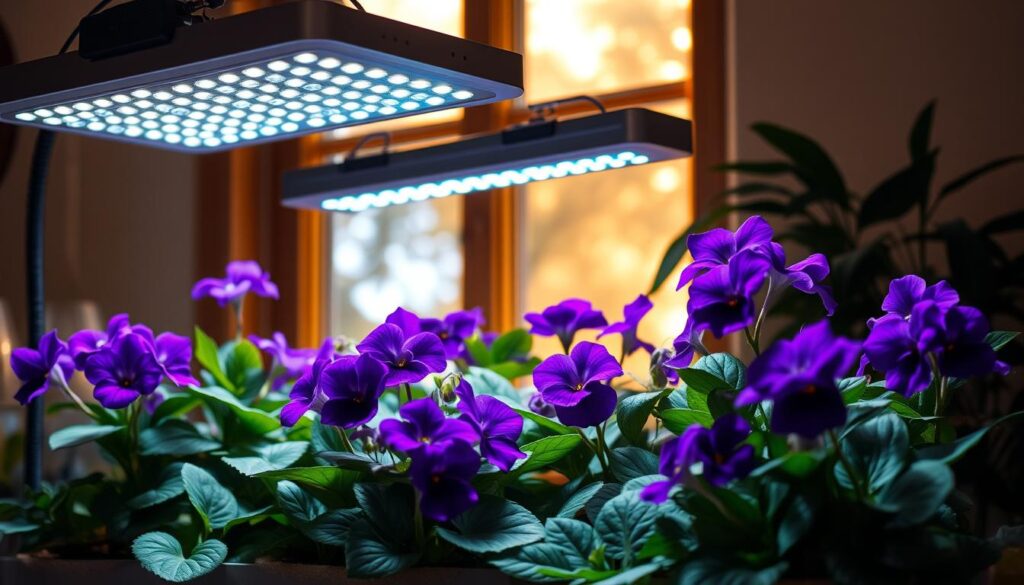
Temperature Management Under Artificial Lights
Using african violet grow lights or other indoor plant lighting is key. It’s important to manage temperature for your African violets’ health and growth. Knowing the heat output of different lights helps create the best growing space.
Heat Considerations
Fluorescent lights, like T12 bulbs, produce more heat than others. This extra heat is good in cooler places, keeping African violets at the right temperature. LED lights, however, give off much less heat. You might need to add heat in cold places for your plants to do well.
Ventilation Requirements
Good air flow is crucial with artificial lights to avoid heat buildup. African violets need a temperature between 20-25°C (68-77°F) to grow well. Fans or air systems help keep air moving, especially in small spaces, to prevent heat stress.
Knowing how different lights heat up and using good ventilation helps your African violets thrive. This way, they can grow well under artificial light.
Budget-Friendly Lighting Solutions
Growing African violets doesn’t have to be expensive. There are many affordable lighting options for these plants. You can choose from standard fluorescent shop lights to energy-saving LED strips.
The SANSI Pot Clip-on Led Lamps are a great choice. They are small but powerful, giving the light of a 60-watt bulb but using less energy. They last up to 25,000 hours, saving money over time compared to bulbs that need to be replaced often.
LED light strips are another affordable option. They let you adjust the light area and intensity for your African violets. Many kits come with dimmers for fine-tuning the light.
- Regular LED bulbs can also be used as budget-friendly grow lights for African violets, providing the necessary full-spectrum illumination.
- DIY setups using LED light tape and dimmers offer a highly customizable and wallet-friendly approach to lighting.
LEDs might cost more upfront than fluorescent bulbs. But, they save energy and last longer, making them a better value over time. By combining different lights or using adjustable systems, you can create an effective lighting setup for your African violets without spending too much.
| Light Source | Initial Cost | Energy Efficiency | Lifespan |
|---|---|---|---|
| Fluorescent Bulbs | $ | Moderate | 6 months |
| LED Lights | $$ | High | 25,000 hours |
| LED Light Strips | $ | High | Durable |
With a bit of creativity and research, you can find affordable lighting for your African violets. This way, you can nourish your plants without breaking the bank.
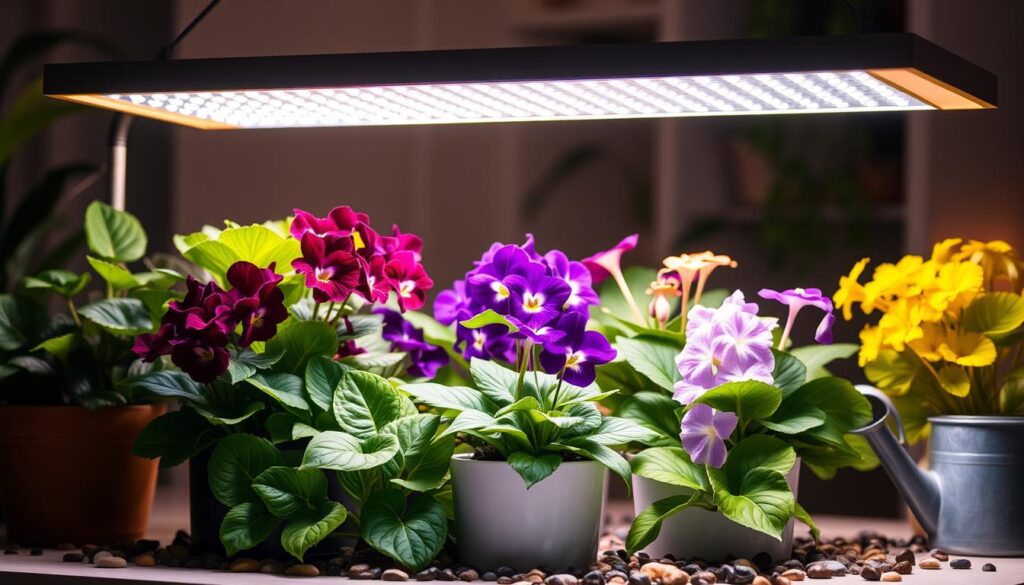
Advanced LED Growing Techniques
LED grow lights are changing how we grow plants indoors. Growers are now using new techniques to get the most out of these lights. These methods let growers control and customize the lighting for their plants.
Dimming Capabilities
Modern LED grow lights can be dimmed. This is different from old lighting systems. Growers can adjust the light intensity to meet their plants’ needs.
By changing the light, growers can give their African violets the right amount of led grow lights for violets. This ensures the plants get the best light at every stage of growth.
Light Cycling Methods
LED grow lights can also be set to mimic natural light. Growers can program the lights to get brighter like the sun and dimmer like sunset. This helps plants grow naturally.
Some growers even change the light spectrum for different growth stages. They use special wavelengths to help plants grow and bloom better. These advanced techniques help create a perfect lighting environment for African violets, leading to healthier plants.
Common Lighting Mistakes to Avoid
Getting the right lighting for your African violets is key to their health and beauty. Many common mistakes can harm their growth. It’s important to know the african violet lighting requirements to avoid these mistakes and keep your garden thriving.
One big mistake is giving them too much or too little light. Too much direct sunlight can make leaves turn white and damaged. Not enough light makes them grow too long and not bloom well. Keeping the light consistent is also vital, as changes can upset their natural growth.
Another mistake is not placing the grow light for african violets correctly. Not changing the light’s intensity or time as the plants grow can slow them down. Watching your plants closely and adjusting the light as needed is crucial.
- Providing the right balance of light intensity and duration
- Ensuring consistent lighting schedules
- Adjusting light placement and intensity as plants grow
By avoiding these common lighting mistakes, you can create the best environment for your African violets. Keep an eye on them and adjust the light as needed. This will help your plants grow strong and bloom beautifully.
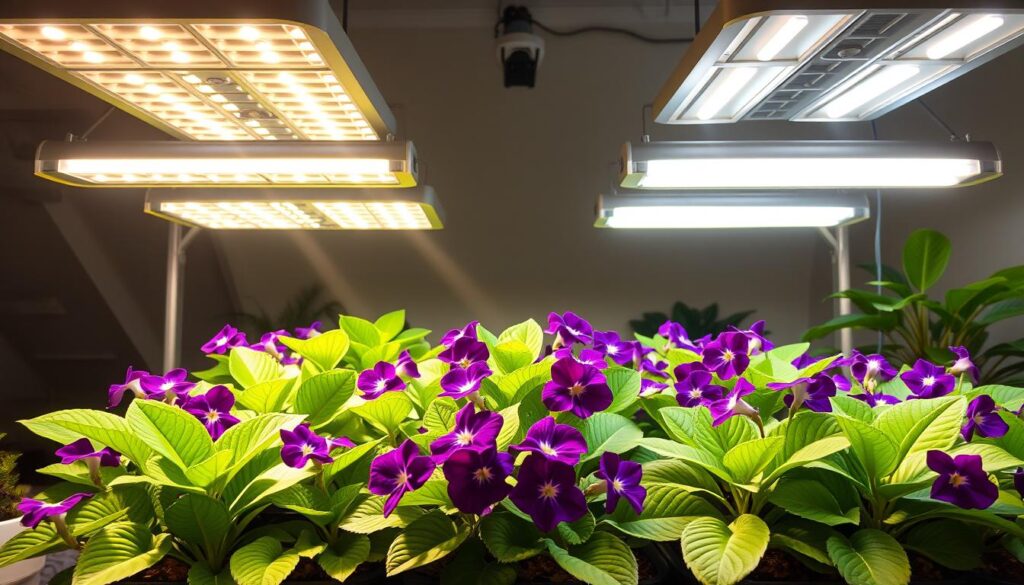
“Proper lighting is essential for African violets, with exposure to too much direct sunlight causing pale leaves and potential leaf curling.”
Seasonal Lighting Adjustments
Keeping African violets healthy all year needs changes in lighting. In winter, when it’s darker, more artificial light helps. In summer, less artificial light is needed if they get sun.
Some growers change the light color too. In winter, they use cooler, bluer light to match daylight. In summer, warmer, redder light helps. This keeps the plants healthy and blooming.
It’s important to watch how plants react and adjust the light slowly. This way, plants get the best light all year. Whether it’s the dark winter or the sunny summer, they thrive.
